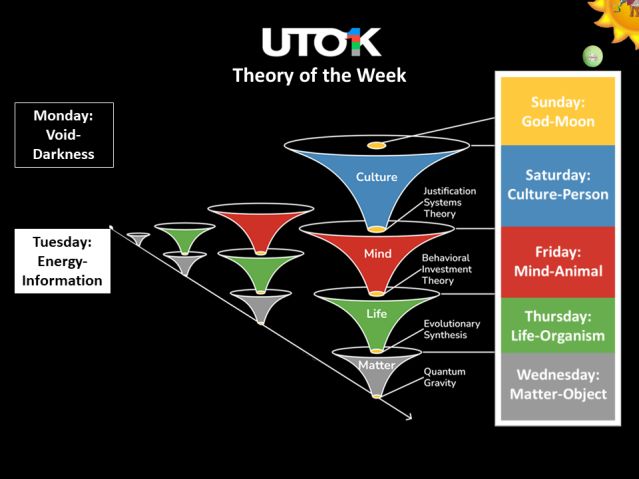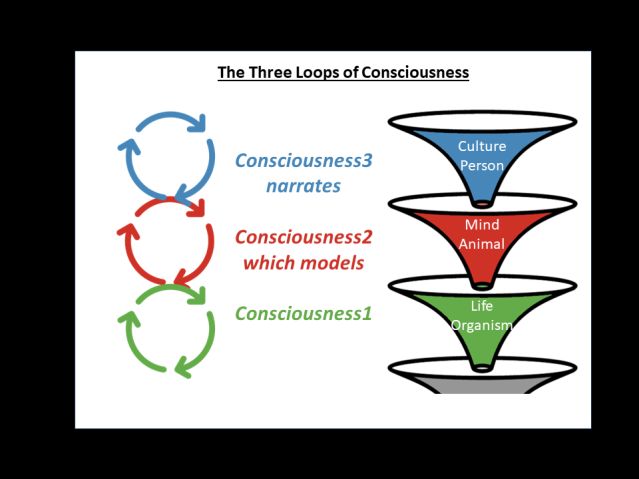Consciousness
The Three Loops of Human Consciousness
We can frame human consciousness via three loops.
Posted July 15, 2024 Reviewed by Michelle Quirk
Key points
- Mindedness refers to how animals act on and in their environment.
- Humans have excellent capacities to read the others' intentions and sync our attention toward complex goals.
- The evolution of propositional language was a tipping point in human consciousness.
This post was co-authored with Professor John Vervaeke.
A recent post unpacked the many meanings associated with consciousness. First, it divided the term into three broad meanings. The first domain was labeled Consciousness1. It was called “creature consciousness,” which refers to the properties of being awake and functionally aware and responsive to the world. It is present in various forms in all living creatures. The second domain, Consciousness2, was labeled subjective consciousness. It refers to the inner experience, or the felt sense of what it is like to be in the world. It likely requires a brain, and so it is only present in animals. Consciousness3 referred to self-reflective awareness and narrating. Its full form requires propositional language, and so is only present in human persons.
In this post, we want to put these three domains together to give you a frame of reference so you can better understand your consciousness. This can be accomplished via a simple saying: Consciousness3 narrates Consciousness2 which models Consciousness1.
To see how they can come together, take a moment and repeat out loud, the following statement: “I am a cultured person who is also a minded animal who is also a living organism who is also a material object that resides on a space-time grid in a larger energy information field.” The reason for saying it out loud is that it brings in your body and links the inside-out point of view with the outside-in behaviors.
As you say this, you are achieving a coherent integrated identity across the layers in nature. What are the layers of nature? According to UTOK, the Unified Theory of Knowledge, there are five primary layers, which are mapped by the Tree of Knowledge System. First, there is the Energy-Information Implicate Order. This is the layer that exists beneath matter, that we see both when we go “down” into quantum field theory and back into the beginning of the observable universe, when all the matter, space, and time, were condensed into an energy-information singularity.
Out of that sprang the second layer, which is the Matter-Object plane of existence. In terms of complexity, this goes from particles to atoms to molecules, and stretches across the scales of space, time, and mass, from the domain of the quantum all the way to the universe as a whole. Then there is the Life-Organism plane, which is mapped by the biological Tree of Life, and is the domain of genes, cells, and multi-celled organisms living in different ecologies. Then there is the Mind-Animal plane, which consists of animals with brains and complex active bodies that engage in things like mating and predation. It appeared about a half a billion years ago. Finally, there is the Culture-Person plane, which includes self-conscious humans who have propositional language and can justify their actions to themselves and others on the social stage.
To help this model of the universe come alive, folks who follow UTOK have aligned it with the days of the week. To do so, the five layers are bookended by “the void,” which aligns with Monday, and “the concept of God,” which aligns with Sunday. The alignment of the ToK System and the days of the week is shared below.

Human consciousness manifests itself as the integrated informational patterns across the stack. In humans, the domain of Consciousness1 includes both the body and the nonconscious neurocognitive processes that allow animals to act on their environment. Here “nonconscious” is defined as distinct from the second meaning of consciousness (i.e., subjective conscious experience). We know much mental activity is nonconscious in this sense. Put differently, Consciousness2 is a special kind of neurocognitive process that gives rise to subjective experience.
Via the ToK, UTOK identifies the Mind-Animal plane of existence as the domain of mindedness. Mindedness refers to how animals act on and in their environment. This is important because it gives us a framework for what subjective consciousness in animals is doing. It is representing, mapping, or modeling mindedness, which is the agent-arena relationship that the animal is in. And Consciousness2 emerges then as a higher-order representation or model of that relationship. In this way, we can think of your subjective experience as a kind of virtual reality simulation that is modeling your place in the world.
Why did a virtual model that provides us with a subjective point of view evolve? One plausible answer is that it allows animals to simulate the environment and to track what is relevant to them. This seems to be what the cortex does, and it is clear that the cortex is important for Consciousness2 in humans.
As highly social primates, humans have excellent capacities to read the intentions of others and sync up our attention toward complex goals like hunting. This tied our subjective experiences together into a richer intersubjective field, which set the stage for symbolic communication that would, in turn, evolve into propositional language. As UTOK makes clear with Justification Systems Theory (JUST), the evolution of propositional language was a tipping point in human consciousness because it required a new, self-reflecting narrating stance that could legitimize actions in response to questions.
So, what does all this mean about the mystery of human consciousness? It means we can think of it as a stack of integrated information across the Life-Organism (i.e., creature consciousness), Mind-Animal (i.e., subjective consciousness), and Culture-Person (i.e., self-consciousness) planes of existence. And we can capture its basic structure via the saying, Consciousness3 narrates Consciousness2 which models Consciousness1.

John Vervaeke, Ph.D., is an associate professor at the University of Toronto. He is the author and presenter of the YouTube series, "Awakening from the Meaning Crisis."
References
Gregg Henriques. The Energy Information Implicate Order that Started It All. Medium. October 16, 2021.




